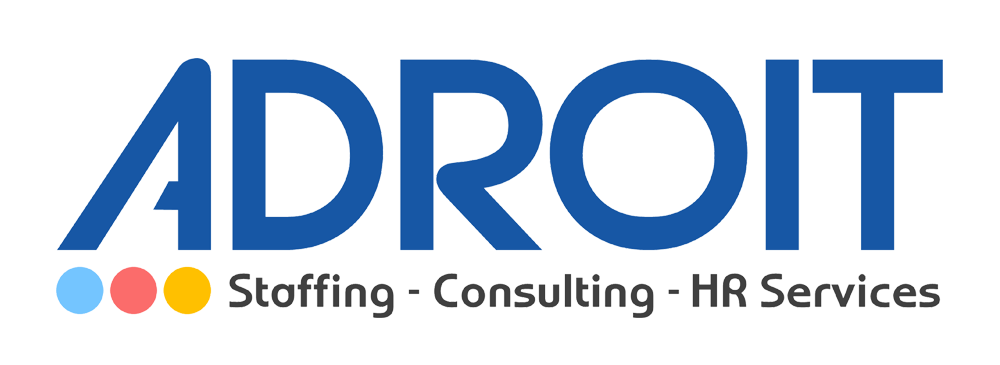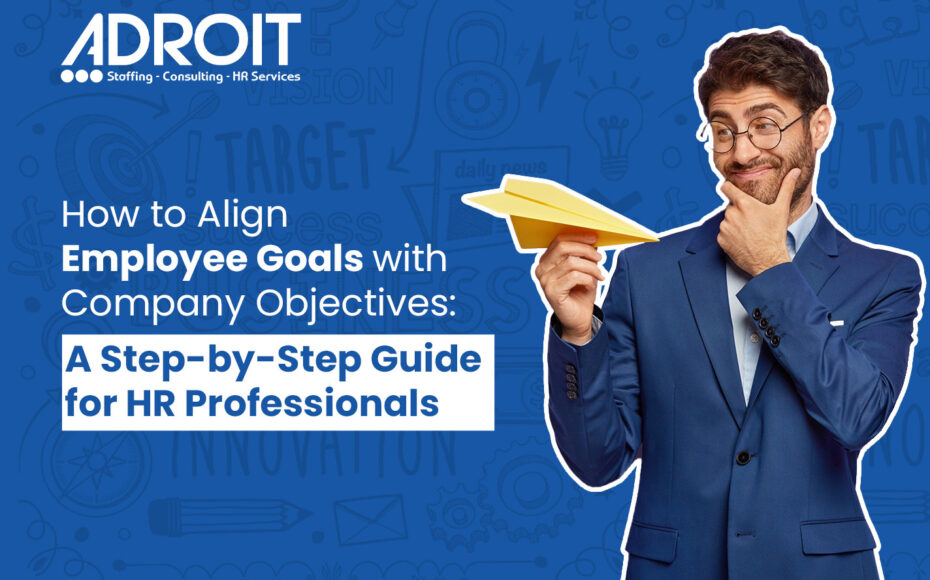Blogs
- Home
- Resources
- blogs
Introduction
Aligning employee goals with company objectives is essential for driving success within an organization. When employees understand how their individual performance contributes to the company’s bigger picture, they are more motivated, engaged, and productive. However, achieving this alignment requires clear communication, effective goal-setting practices, and consistent feedback. In this blog, we’ll explore strategies HR professionals can use to ensure that employees’ goals are aligned with the overall mission and vision of the company.
1. Clearly Define Company Objectives
Before aligning employee goals with the company’s objectives, it’s essential to have a clear understanding of the company’s short-term and long-term goals. These objectives should be clearly articulated and communicated across all levels of the organization.
- Why It’s Important: Employees cannot align their goals with company objectives if they don’t fully understand those objectives. Clear communication ensures everyone is on the same page, which leads to better performance and results.
- How to Do It: Start by working with leadership to identify the company’s strategic priorities. Break down these priorities into specific, measurable goals that employees can relate to. Use internal communications tools, such as town halls or company-wide meetings, to communicate these objectives to all staff.
2. Implement SMART Goals for Employees
SMART goals (Specific, Measurable, Achievable, Relevant, and Time-bound) provide a clear framework for setting goals that are aligned with the company’s objectives. When employees have SMART goals, they can easily see how their work impacts the organization’s overall mission.
- Why It’s Important: Without well-defined goals, employees may feel lost or unclear about how their contributions fit into the bigger picture. SMART goals ensure that employees have a clear understanding of what is expected and how success will be measured.
- How to Do It: Work with employees to set individual SMART goals that directly contribute to company objectives. For example, if your company’s goal is to increase sales, set individual targets for each employee that contribute to achieving that goal, such as increasing client engagement or expanding product knowledge.
3. Establish Regular Check-Ins and Feedback
Aligning employee goals with company objectives is an ongoing process that requires regular check-ins and feedback. By maintaining consistent communication with employees about their progress toward their goals, you can ensure they remain focused and motivated.
- Why It’s Important: Regular feedback helps employees stay on track and provides opportunities to address any challenges or misalignments early. It also reinforces the connection between individual contributions and company success.
- How to Do It: Schedule regular one-on-one meetings between managers and employees to review progress, discuss challenges, and provide feedback. Use performance management tools to track progress and identify areas for improvement. Encourage open and honest communication to address any concerns and realign goals if necessary.
4. Promote a Collaborative and Cross-Departmental Approach
Often, employees work in silos, focusing on their own tasks without considering how their work fits into the larger organizational framework. By encouraging collaboration across teams and departments, you can help employees understand how their contributions fit into the broader company objectives.
- Why It’s Important: Cross-departmental collaboration fosters a sense of unity and shared responsibility for achieving company goals. It also allows employees to see how their work directly impacts other areas of the organization.
- How to Do It: Organize team meetings, workshops, or cross-functional projects where employees from different departments can come together to discuss how their work aligns with company objectives. Encourage knowledge sharing and problem-solving as a collective effort.
5. Incorporate Employee Development into Goal Alignment
Aligning employee goals with company objectives isn’t just about setting targets; it’s also about providing employees with the tools, training, and development they need to succeed. Offering opportunities for growth and skill-building ensures employees are equipped to meet their goals.
- Why It’s Important: When employees have the right skills and resources, they are more likely to achieve their goals and, in turn, contribute to the company’s success. Development opportunities also increase employee engagement and satisfaction.
- How to Do It: Offer training programs, mentorship opportunities, and access to learning resources that help employees develop the skills they need to meet their goals. Incorporate learning and development as part of the goal-setting process and encourage employees to seek out growth opportunities that align with both their personal career goals and company objectives.
6. Recognize and Reward Achievements
Recognition and rewards play a critical role in maintaining employee motivation and ensuring alignment with company objectives. When employees see that their hard work is acknowledged and appreciated, they are more likely to stay engaged and committed to achieving their goals.
- Why It’s Important: Recognition reinforces the connection between individual performance and company success. It boosts morale, encourages continued effort, and strengthens employees’ commitment to the organization’s goals.
- How to Do It: Create a recognition program that highlights achievements tied to company objectives. Offer both monetary and non-monetary rewards, such as bonuses, promotions, public recognition, or opportunities for career advancement. Ensure that recognition is timely and specific, focusing on the impact of the employee’s contribution to company goals.
7. Align Company Culture with Goals
A strong company culture can serve as the foundation for aligning employee goals with company objectives. When the company’s values and mission are deeply embedded in its culture, employees are more likely to feel connected to the overall vision and understand how their individual contributions matter.
- Why It’s Important: Company culture influences employee behavior, decision-making, and performance. When employees feel connected to the company’s values and mission, they are more likely to align their goals with the broader organizational objectives.
- How to Do It: Foster a company culture that emphasizes teamwork, accountability, and shared goals. Make sure that employees understand the company’s values and how their role contributes to the larger mission. Reinforce cultural alignment through onboarding, team-building activities, and leadership communication.
Conclusion
Aligning employee goals with company objectives is a strategic process that requires clear communication, goal-setting, regular feedback, and a supportive work environment. By following these best practices, HR professionals can help employees stay focused on their individual goals while ensuring those goals contribute to the success of the organization. When employees understand how their work supports company objectives, they are more motivated, engaged, and empowered to drive business success.
By aligning employee goals with company objectives, you’re not only fostering a more productive workforce but also positioning your company for long-term growth and success.
Introduction
In 2025, employee engagement is more important than ever. With a rapidly changing work environment, evolving expectations from employees, and the rise of remote and hybrid work models, it’s essential for companies to find innovative ways to engage and motivate their workforce. Engaged employees are more productive, satisfied, and loyal to their companies. In this blog, we’ll explore 10 creative and effective strategies to boost employee engagement in 2025 and ensure your team remains committed and excited about their work.
1. Gamify Employee Recognition and Rewards
Gamification can transform the traditional employee recognition system into a fun and engaging experience. By introducing elements like point systems, leaderboards, and badges for achievements, employees can earn rewards in a competitive and interactive way.
- Why It Works: Gamification taps into employees’ natural desire for competition, recognition, and achievement. It adds an element of fun while also motivating employees to perform at their best.
- How to Implement It: Use platforms or tools that allow you to create gamified systems for recognizing accomplishments. Employees can earn points for meeting goals, completing tasks, or embodying company values, and redeem them for rewards such as gift cards, time off, or special privileges.
2. Focus on Employee Well-Being
The importance of mental health and well-being cannot be overstated. In 2025, employees are looking for companies that care about their holistic well-being, including their physical, emotional, and mental health.
- Why It Works: Prioritizing employee well-being not only boosts engagement but also reduces burnout and absenteeism, leading to a more productive and satisfied workforce.
- How to Implement It: Offer flexible work hours, wellness programs, meditation or mindfulness sessions, gym memberships, and mental health support. Encourage a healthy work-life balance by allowing employees to take time off when needed and creating an environment where they feel comfortable discussing their mental health.
3. Offer Personalized Learning and Development Opportunities
Employees are increasingly seeking companies that invest in their professional growth. Offering personalized learning and development (L&D) opportunities can greatly enhance employee engagement by helping them build new skills and grow in their careers.
- Why It Works: Employees are more likely to feel engaged when they see opportunities for career advancement and personal development. Tailored L&D programs show employees that the company is invested in their success.
- How to Implement It: Create a learning platform that allows employees to choose courses based on their interests and career goals. Offer mentorship programs, attend conferences, or bring in industry experts for internal workshops and training sessions.
4. Introduce Flexible Work Environments
With hybrid and remote work becoming more common, flexibility is key to employee engagement in 2025. Allowing employees to choose where and when they work can help foster a sense of autonomy and trust.
- Why It Works: Employees value the flexibility to work in a way that suits their personal lives, boosting their satisfaction and reducing stress. It also helps attract and retain top talent.
- How to Implement It: Offer flexible hours, remote work options, or even a “work-from-anywhere” policy. Invest in tools that support remote work, like project management software and communication platforms, to ensure employees can stay connected and productive, regardless of their location.
5. Foster a Culture of Transparency
Transparency in decision-making, communication, and leadership builds trust and a strong sense of connection among employees. When employees feel they are in the loop and their opinions matter, they are more likely to engage and contribute to the company’s success.
- Why It Works: Transparent organizations create a sense of ownership and accountability. When employees understand company goals and how they contribute to them, they are more motivated to perform well.
- How to Implement It: Regularly communicate with employees about company updates, changes, and strategies. Encourage an open-door policy where employees feel comfortable discussing their concerns and providing feedback.
6. Celebrate Milestones and Achievements
Celebrating milestones, whether it’s a personal achievement or a company-wide success, can help employees feel valued and appreciated. Acknowledging both small and big wins boosts morale and reinforces a sense of belonging.
- Why It Works: Celebrations create a positive environment where employees feel acknowledged for their contributions. It also fosters camaraderie and team spirit.
- How to Implement It: Recognize birthdays, work anniversaries, promotions, and project completions with celebrations, virtual happy hours, or personalized thank-you notes. Ensure employees receive public acknowledgment during company-wide meetings or through internal communication channels.
7. Create Opportunities for Social Connections
Employees are more engaged when they feel they belong to a strong community within the company. Building social connections at work can help reduce feelings of isolation, especially for remote workers, and increase overall engagement.
- Why It Works: Social interactions lead to stronger relationships, better teamwork, and improved collaboration. Employees who have positive relationships with their colleagues are more likely to stay engaged and productive.
- How to Implement It: Organize virtual and in-person social events, team-building activities, and interest-based clubs or groups. Host “lunch and learn” sessions or informal get-togethers to encourage casual networking and social bonding.
8. Encourage Autonomy and Empower Employees
Empowering employees by giving them more control over their work fosters a sense of ownership and responsibility. Allowing employees to make decisions and take initiative can increase engagement and drive.
- Why It Works: When employees are trusted with greater autonomy, they feel more motivated to contribute their ideas and skills. It also fosters creativity and innovation.
- How to Implement It: Encourage employees to take on leadership roles in projects or initiatives. Support them in making decisions and give them the flexibility to explore new ideas without fear of failure.
9. Provide Clear Career Paths and Growth Opportunities
Employees who understand their potential career paths within the company are more likely to stay engaged and committed. Offering clear advancement opportunities allows employees to see a future with the organization and motivates them to perform at their best.
- Why It Works: Employees are more engaged when they see that their hard work will be rewarded with career growth and development.
- How to Implement It: Develop transparent career progression frameworks and ensure that employees are aware of the skills and achievements required for promotion. Regularly check in with employees about their career goals and aspirations.
10. Promote Work-Life Balance
A healthy work-life balance is essential for keeping employees engaged and preventing burnout. Encourage employees to take time off, disconnect from work, and focus on their personal lives.
- Why It Works: When employees feel supported in maintaining a work-life balance, they are more likely to be productive, satisfied, and engaged in their roles.
- How to Implement It: Encourage employees to set boundaries between work and personal life. Offer flexible time off, mental health days, and a supportive environment where employees feel comfortable prioritizing their well-being.
Conclusion
In 2025, boosting employee engagement requires creativity, flexibility, and a focus on well-being, development, and work-life balance. By implementing these 10 creative strategies, companies can cultivate a positive and motivated workforce that drives success and growth. Remember, engagement is not a one-time initiative—it’s an ongoing effort that requires consistent attention, feedback, and adaptability. Start applying these strategies today to ensure your employees are engaged, motivated, and ready to contribute to your company’s future success.
Introduction
In today’s competitive job market, the ability to build and maintain a strong talent pool is one of the most valuable assets an organization can have. By creating a pipeline of qualified candidates, businesses can fill open roles more efficiently and reduce recruitment costs in the long run. But how do you build and maintain a talent pool that consistently delivers top talent? In this guide, we’ll explore effective strategies to help you build a strong, diverse talent pool and keep it healthy for future hiring needs.
1. Understand Your Hiring Needs and Company Goals
Building a talent pool starts with understanding your organization’s long-term goals and the skills required to meet those objectives. Identifying your hiring needs, both short-term and long-term, will give you a clearer idea of the kind of talent you need to attract.
- Why It’s Important: Without a clear understanding of your company’s goals, you may end up targeting the wrong candidates or failing to recruit for future skill gaps.
- How to Do It: Work with hiring managers, team leads, and leadership to create a detailed hiring plan that aligns with your business goals. Assess both current staffing needs and future talent requirements, keeping in mind any upcoming projects, expansions, or industry changes.
2. Leverage Technology to Build Your Talent Pool
In 2025, technology is at the forefront of talent acquisition. Using the right tools and platforms can help you quickly build and manage your talent pool. Recruitment software, ATS (Applicant Tracking Systems), and job boards are crucial tools in reaching potential candidates.
- Why It’s Important: Technology streamlines the process of collecting and organizing candidate information, helping you build a comprehensive database of qualified candidates.
- How to Do It: Invest in recruitment platforms and tools that enable you to easily collect, sort, and manage candidate profiles. Leverage social media platforms, like LinkedIn and Twitter, to connect with potential candidates and build your network.
3. Establish an Employee Referral Program
Employee referral programs remain one of the most effective ways to build a high-quality talent pool. When current employees refer someone for a job, they’re essentially vouching for the candidate’s capabilities and fit with the company culture.
- Why It’s Important: Referred candidates are often a better fit for the role and the company culture, as employees typically know what the job requires and who would be a good fit.
- How to Do It: Create a formal referral program that rewards employees for successfully referring candidates. Make sure your employees understand the benefits of referring top talent and provide them with the resources to do so. Communicate the program through internal channels to keep it top of mind.
4. Create an Engaging Careers Page
Your company’s careers page is often the first interaction potential candidates have with your organization. A well-designed, engaging careers page can help attract top talent by showcasing your company culture, values, and the benefits of working with you.
- Why It’s Important: An appealing careers page serves as both a marketing tool and a talent pool attraction mechanism, giving candidates a clear understanding of your company’s ethos and the opportunities available.
- How to Do It: Make sure your careers page is visually appealing, easy to navigate, and informative. Include employee testimonials, company values, career advancement opportunities, and the perks of working with your organization. Always include an option for candidates to join your talent pool even if no specific job openings are available.
5. Engage with Passive Candidates
Building a talent pool isn’t just about collecting active job seekers; it’s also about reaching out to passive candidates—those who aren’t actively looking for a job but could be interested in future opportunities.
- Why It’s Important: Passive candidates make up a large portion of the talent market and can often be more qualified and experienced than active job seekers.
- How to Do It: Engage with passive candidates through social media, email newsletters, and networking events. Keep them updated on your company’s activities and career opportunities, even if they’re not actively looking for a job. You can use email nurturing campaigns or LinkedIn outreach to stay in touch and remind them of your organization’s value.
6. Build Strong Employer Branding
A key component in attracting the right talent is strong employer branding. A company that has a positive image and reputation will naturally attract top-tier candidates to its talent pool.
- Why It’s Important: Candidates want to work for companies that have a great reputation for work culture, employee satisfaction, and growth opportunities.
- How to Do It: Invest in employer branding initiatives that showcase your company’s culture, mission, and values. Encourage employees to share their positive experiences online, whether on social media or job review platforms like Glassdoor. Promote your company’s work environment and benefits as a key selling point for top talent.
7. Maintain Consistent Communication
Once you’ve started building a talent pool, it’s important to keep in touch with potential candidates regularly. Candidates who feel engaged and valued are more likely to stay interested in future roles at your company.
- Why It’s Important: Keeping candidates engaged helps ensure they stay in your pipeline for when you have a relevant job opening. It also demonstrates your company’s commitment to ongoing relationships.
- How to Do It: Send periodic updates to your talent pool, such as job alerts, company news, and career development opportunities. This can be done via email, newsletters, or social media channels. Make sure to personalize communications to maintain a genuine connection.
8. Offer Training and Development Opportunities
Offering training and development programs can help you attract candidates who are interested in growing within your organization. It also ensures that your existing talent pool is continually evolving with new skills, which is crucial in a rapidly changing job market.
- Why It’s Important: Employees are more likely to stay with a company that invests in their professional development. Training programs also help you build a stronger talent pool by enhancing your employees’ skillsets.
- How to Do It: Implement internal training programs, mentorship opportunities, and learning resources. Highlight these offerings when engaging with candidates to show that your company values continuous learning and career growth.
Conclusion
Building and maintaining a strong talent pool is an ongoing process that requires time, effort, and the right strategies. By focusing on understanding your hiring needs, leveraging technology, engaging with passive candidates, and maintaining strong relationships, you can create a pool of qualified candidates that are ready to fill your open roles at any time. With a solid talent pool in place, you can streamline your hiring process, reduce time-to-hire, and ensure your company is always prepared for future growth.
By investing in your talent pool today, you are setting your organization up for long-term success and sustainability.
Introduction
In 2025, the job market is more competitive than ever, and your resume is still one of the most powerful tools you have to land your dream job. While the fundamental purpose of a resume remains the same—to showcase your skills, experience, and qualifications—the way you present that information is evolving. To stand out in the digital age, your resume needs to not only highlight your abilities but also reflect your adaptability, digital literacy, and personal brand. In this blog, we will guide you on how to write a resume that stands out in 2025 and increases your chances of landing the job you want.
1. Prioritize Digital Skills and Technical Competencies
As technology continues to reshape the workplace, digital literacy is becoming an essential requirement in almost every job. In 2025, employers will expect candidates to demonstrate proficiency in digital tools and software relevant to their field.
- Why It’s Important: Highlighting digital skills on your resume shows that you are adaptable and able to navigate the evolving tech landscape.
- How to Do It: List any relevant software, platforms, or tools you’ve mastered, such as CRM systems, project management tools (like Trello or Asana), data analysis programs (like Excel or Tableau), or specialized industry software.
2. Tailor Your Resume for Each Job Application
One of the most important tips for writing a standout resume is customization. In 2025, generic resumes are less likely to capture the attention of hiring managers. With the help of Applicant Tracking Systems (ATS) being widely used, tailoring your resume to each job description will ensure you make it through the initial screening.
- Why It’s Important: Customizing your resume increases your chances of passing the ATS screening process and shows that you’ve taken the time to understand the job requirements.
- How to Do It: Carefully read through the job posting and incorporate keywords and phrases that align with the role. Highlight the skills, experience, and accomplishments most relevant to the job.
3. Showcase Your Soft Skills and Emotional Intelligence
In addition to technical competencies, employers in 2025 will increasingly value soft skills and emotional intelligence (EQ). Skills such as communication, teamwork, problem-solving, and adaptability will set you apart as a candidate who can thrive in a collaborative and fast-paced work environment.
- Why It’s Important: Soft skills demonstrate your ability to work well with others, manage stress, and navigate interpersonal challenges—all key traits for success in the workplace.
- How to Do It: Highlight soft skills in your professional experience section by providing examples of how you’ve used them to achieve success. For example, “Collaborated with cross-functional teams to streamline workflow and improve project completion time by 30%.”
4. Incorporate Metrics and Results
Quantifying your achievements is one of the most effective ways to make your resume stand out. Employers are looking for candidates who can drive results, and metrics provide a clear, tangible way to showcase your impact.
- Why It’s Important: Numbers demonstrate your ability to achieve goals and make a measurable impact, which makes your accomplishments more convincing to hiring managers.
- How to Do It: Whenever possible, use specific numbers to describe your achievements. For example, “Increased website traffic by 40% within six months” or “Managed a team of 10, leading to a 20% increase in productivity.”
5. Include a Personal Branding Statement
In 2025, your resume needs to reflect your unique professional identity. A personal branding statement, located near the top of your resume, allows you to succinctly communicate what you bring to the table and what makes you stand out as a candidate.
- Why It’s Important: A personal branding statement helps you position yourself as the ideal candidate by articulating your skills, values, and career objectives in a way that resonates with employers.
- How to Do It: Write a short, impactful statement (2-3 sentences) that highlights your key skills, experience, and career goals. For example, “Experienced marketing professional with a passion for data-driven strategies and a proven track record in boosting brand awareness and increasing sales.”
6. Optimize for ATS (Applicant Tracking Systems)
In 2025, most companies will still rely on ATS to screen resumes before they even reach a human recruiter. If your resume isn’t optimized for ATS, it may never make it past the first round.
- Why It’s Important: ATS helps hiring managers process large volumes of applicants, but if your resume isn’t ATS-friendly, you might be overlooked even if you’re highly qualified.
- How to Do It: Use standard fonts (e.g., Arial, Calibri), avoid complex formatting (like images, graphs, or tables), and ensure your resume includes relevant keywords that match the job posting. Be sure to list your skills and experience in plain text, as some ATS systems cannot read unusual formatting.
7. Leverage Social Media Links and Online Presence
In 2025, employers often review candidates’ online presence before making a hiring decision. Including links to your professional social media profiles (e.g., LinkedIn) or personal portfolio websites can help employers learn more about you and your work.
- Why It’s Important: Providing links to your online profiles gives employers access to your professional background, endorsements, and additional work samples.
- How to Do It: Include a LinkedIn URL, personal website, or portfolio link at the top of your resume. Be sure your online profiles are up to date and reflect your professional persona accurately.
8. Keep Your Resume Clean and Easy to Read
While modern resumes are expected to include various skills and accomplishments, readability is key. Hiring managers and recruiters spend mere seconds scanning a resume, so it’s important to keep it concise, well-organized, and visually appealing.
- Why It’s Important: A cluttered or overly complex resume can quickly turn off a hiring manager. A clean, well-organized resume makes it easy for them to see your qualifications at a glance.
- How to Do It: Use clear section headings, bullet points for easy reading, and enough white space to make your resume easy to scan. Stick to one or two pages, focusing on the most relevant information.
9. Include Volunteer Work and Side Projects
In 2025, employers are not just looking at your formal work experience. They want to see what else you’ve been doing to develop your skills and contribute to your community or personal interests. Volunteer work and side projects can demonstrate initiative, leadership, and a passion for making a difference.
- Why It’s Important: Including volunteer work or side projects on your resume adds depth to your profile and shows that you’re committed to personal growth and social responsibility.
- How to Do It: List relevant volunteer experiences or side projects in a separate section of your resume, highlighting your key responsibilities and accomplishments.
Conclusion
Writing a resume in 2025 requires more than just listing your work history. Employers are looking for candidates who can demonstrate adaptability, digital skills, and a track record of achieving results. By tailoring your resume to the specific job, incorporating metrics and results, and highlighting your soft skills, you can significantly improve your chances of standing out to hiring managers. Remember, your resume is your personal marketing tool—make sure it reflects your unique strengths and shows employers why you’re the right fit for the job.
Introduction
Human Resources (HR) has always played a pivotal role in any organization, but with the ever-evolving workplace dynamics, the skills required for HR professionals have also transformed. The modern HR professional needs to be agile, tech-savvy, and capable of managing a diverse range of responsibilities. As businesses increasingly focus on employee well-being, organizational development, and strategic planning, HR professionals must possess a versatile skill set to drive success. In this blog, we’ll explore the essential HR skills required for the modern HR professional to thrive in today’s fast-paced and dynamic business environment.
1. Strategic Thinking
HR is no longer just about managing payroll and handling employee disputes. Today, HR professionals are seen as strategic partners who contribute to business growth by aligning talent management practices with organizational goals.
- Why It’s Important: Strategic thinking helps HR professionals anticipate business needs and proactively address potential talent shortages or skill gaps.
- How to Develop It: Gain a deep understanding of the business, its goals, and industry trends. Collaborate with leadership teams to align HR practices with business objectives.
2. Data-Driven Decision-Making
In today’s data-rich environment, HR professionals must be able to collect, analyze, and leverage data to make informed decisions. From hiring trends to employee performance, data can guide HR practices and improve outcomes.
- Why It’s Important: Data-driven decision-making allows HR professionals to make objective, evidence-based decisions that improve employee engagement, reduce turnover, and optimize recruitment efforts.
- How to Develop It: Familiarize yourself with HR analytics tools and learn how to interpret data such as employee satisfaction surveys, performance reviews, and retention rates.
3. Employee Engagement & Retention
Keeping employees engaged and committed to the organization is crucial for long-term success. HR professionals must develop strategies to foster a positive work environment that nurtures employee satisfaction and loyalty.
- Why It’s Important: High employee engagement leads to increased productivity, reduced turnover, and enhanced company culture.
- How to Develop It: Create and implement engagement programs such as regular feedback sessions, recognition initiatives, and career development opportunities. Listen to employees’ concerns and act on them.
4. Communication Skills
Effective communication is at the heart of HR management. Whether it’s delivering difficult news, negotiating with candidates, or facilitating team-building activities, clear and empathetic communication is essential.
- Why It’s Important: Strong communication skills ensure that HR professionals can effectively convey information, manage conflicts, and build trust across all levels of the organization.
- How to Develop It: Practice active listening, learn how to tailor your message to different audiences, and develop both verbal and written communication skills.
5. Adaptability and Flexibility
The workplace is constantly evolving, and HR professionals need to stay adaptable to changes in technology, policies, and business needs. From embracing new HR technologies to navigating shifting employee expectations, adaptability is key to success.
- Why It’s Important: In a constantly changing environment, HR professionals must be flexible enough to adapt to new tools, trends, and business goals while remaining focused on the overall mission.
- How to Develop It: Stay up-to-date with the latest HR trends, tools, and technologies. Participate in workshops, webinars, and networking events to continuously learn and grow.
6. Emotional Intelligence (EI)
Emotional Intelligence (EI) is the ability to recognize, understand, and manage one’s own emotions as well as the emotions of others. It’s a vital skill for HR professionals, as it helps in handling sensitive situations, resolving conflicts, and fostering healthy workplace relationships.
- Why It’s Important: EI enables HR professionals to connect with employees, manage workplace conflicts, and create a supportive environment where people feel valued.
- How to Develop It: Work on self-awareness, empathy, and emotional regulation. Engage in conversations that help you understand employees’ emotional needs and provide appropriate support.
7. Legal Compliance Knowledge
Staying updated with employment laws and regulations is critical for any HR professional. Non-compliance can lead to legal issues, fines, and damage to the company’s reputation.
- Why It’s Important: A strong knowledge of labor laws, HR compliance, and workplace safety regulations ensures that your organization remains compliant with legal requirements and avoids potential lawsuits.
- How to Develop It: Regularly attend compliance training, read up on labor laws, and consult legal experts when necessary to ensure that HR policies and practices are in line with current regulations.
8. Tech-Savviness
With HR technology constantly advancing, HR professionals must be familiar with a range of tools, from HRMS (Human Resource Management Systems) to recruitment platforms and performance management software.
- Why It’s Important: Technology streamlines HR processes, improves efficiency, and provides real-time data for decision-making. Being tech-savvy allows HR professionals to work smarter, not harder.
- How to Develop It: Stay updated with the latest HR tech solutions and invest time in mastering tools that enhance HR practices such as applicant tracking systems (ATS), payroll software, and employee engagement platforms.
9. Conflict Resolution
Conflicts are inevitable in any workplace, but HR professionals play a crucial role in resolving disputes and maintaining a harmonious work environment.
- Why It’s Important: Conflict resolution skills help address workplace issues swiftly, prevent escalation, and maintain employee morale.
- How to Develop It: Learn various conflict resolution strategies such as mediation, active listening, and negotiation techniques. Create a clear process for resolving employee grievances.
10. Talent Acquisition and Retention
Recruiting top talent and retaining valuable employees is one of the most important responsibilities of HR professionals. You need to develop an in-depth understanding of recruitment processes and employee retention strategies.
- Why It’s Important: Attracting and retaining top talent is crucial for business success, and HR professionals are responsible for ensuring the right people are in the right roles.
- How to Develop It: Invest in recruitment marketing, refine your interview techniques, and develop strategies for employee retention, including competitive benefits, career advancement opportunities, and work-life balance initiatives.
Conclusion
The role of HR professionals has evolved significantly in recent years, requiring a diverse and adaptive skill set. From strategic thinking and data-driven decision-making to emotional intelligence and legal compliance, today’s HR professionals need to be versatile, tech-savvy, and proactive in supporting both organizational growth and employee well-being. By focusing on developing these essential HR skills, you’ll not only contribute to the success of your organization but also position yourself as a valuable and forward-thinking HR leader.
A Step-by-Step Guide
Introduction
Building a strong company culture is not just about creating a fun office environment or offering perks. It’s about laying a solid foundation that aligns with your company values and vision, fostering collaboration, and inspiring loyalty from your employees. Whether you are a startup or an established business looking to reshape your culture, this step-by-step guide will help you build a thriving company culture from the ground up.
Why Company Culture Matters In today’s competitive business world, having a strong company culture isn’t optional; it’s essential for attracting and retaining top talent, improving employee engagement, and driving business success. Companies with a positive culture enjoy higher productivity, employee satisfaction, and better business outcomes. According to studies, organizations with strong cultures are 20% more profitable and 30% more likely to outperform their competitors.
1. Define Your Core Values and Mission
Before you can build a strong culture, you need to clearly define your company’s core values and mission. These values serve as the guiding principles for decision-making, employee behavior, and interactions with customers.
- Start with the Vision: What do you want your company to achieve in the long run? Your mission statement should reflect these aspirations.
- Clarify Your Values: Values such as integrity, collaboration, innovation, and inclusivity should be at the core of your company culture.
2. Lead by Example
Leaders play a crucial role in shaping and maintaining company culture. As a business owner or manager, your behavior sets the tone for the rest of the team. Leaders who embody the company’s values inspire their teams to follow suit.
- Demonstrate Values in Action: If you value transparency, ensure open communication channels.
- Lead with Empathy: Show understanding and respect for your team’s needs, fostering a culture of trust.
3. Create a Positive Work Environment
A strong company culture thrives in an environment that encourages collaboration, creativity, and mutual respect. Consider the physical and emotional well-being of your employees.
- Space Matters: Design a workspace that promotes open communication and collaboration.
- Foster a Culture of Recognition: Regularly acknowledge employees’ hard work through recognition programs and feedback.
4. Hire for Cultural Fit
When hiring new employees, look for candidates who not only have the necessary skills but also align with your company’s values and culture. Hiring employees who fit into your company culture ensures a smoother integration and strengthens the overall culture.
- Use Behavioral Interviews: Ask questions that assess whether candidates share the company’s core values.
- Consider Cultural Fit Over Skill Set: While skills are important, cultural fit can have a greater long-term impact on team dynamics.
5. Encourage Open Communication
Encouraging open communication and transparency within the company is essential for building trust and a positive workplace culture.
- Regular Check-Ins: Schedule one-on-one meetings with employees to listen to their concerns and feedback.
- Feedback Loops: Create channels where employees can give constructive feedback, and ensure it’s acted upon.
6. Develop a Strong Onboarding Process
The onboarding process sets the tone for a new hire’s experience and immersion into your company culture. A well-designed onboarding program helps new employees understand the company values and how they fit within the team.
- Company Orientation: Introduce new hires to the company’s mission, values, and culture from day one.
- Mentorship Programs: Pair new employees with experienced mentors who can guide them through their early days.
7. Provide Opportunities for Growth and Development
A strong company culture is built on the idea of continuous learning and development. When employees feel supported in their growth, they’re more likely to stay engaged and loyal to the company.
- Training Programs: Offer skill-building workshops or access to courses that help employees grow professionally.
- Career Pathways: Provide clear paths for advancement within the company to motivate employees to excel.
8. Foster a Work-Life Balance
Encouraging employees to maintain a healthy work-life balance contributes to overall well-being and job satisfaction. Employees who feel balanced are more engaged, productive, and likely to stay with the company.
- Flexible Work Arrangements: Offer options like remote work, flexible hours, or job-sharing opportunities.
- Employee Wellness Programs: Invest in mental and physical health initiatives to support employee well-being.
9. Continuously Evaluate and Evolve Your Culture
Company culture is not static; it evolves over time. Regularly assess the health of your company culture and make necessary adjustments. Encourage employee feedback to identify areas for improvement.
- Culture Surveys: Regularly survey your employees to gauge their satisfaction and engagement with the company culture.
- Adapt to Change: As your company grows, your culture should evolve to meet new challenges.
Conclusion
Building a strong company culture takes time, effort, and a commitment to consistency. By defining your values, leading by example, and fostering open communication, you can create a workplace where employees are motivated, productive, and aligned with your vision.
Remember, company culture isn’t just a buzzword – it’s the backbone of your organization’s success. Whether you’re a small startup or an established business, investing in a strong company culture will pay off in employee engagement, productivity, and long-term success.







